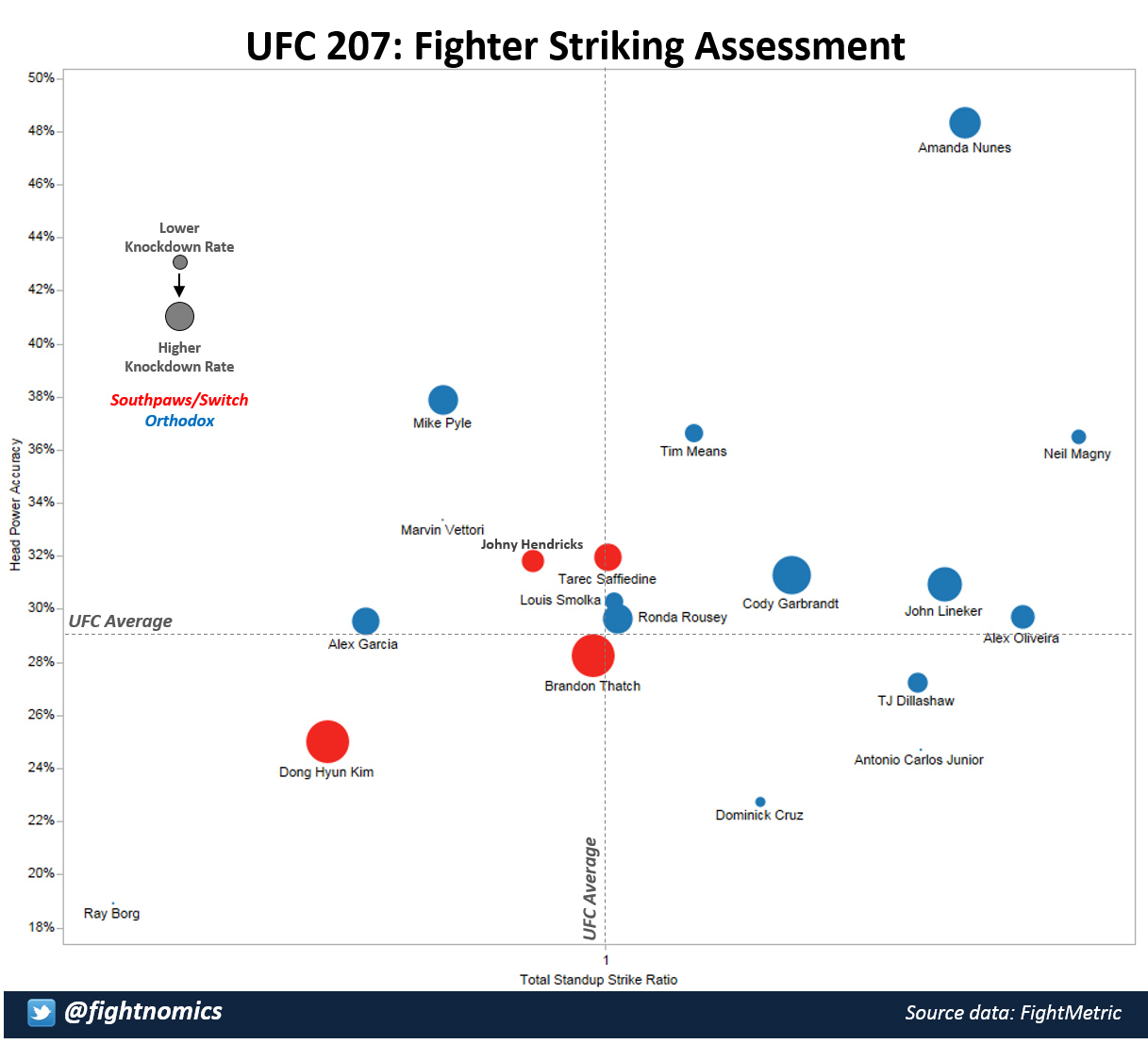The UFC always gives fans a little gift at the end of the year in the form of a stacked fight card, and UFC 207 will be this year's blowout. The main card gifts us two title fights, plus a likely title eliminator, and the return of Ronda Rousey just to put a bow on it.
And sprinkling the fight card throughout will be a variety of excellent strikers, including some high performers in several of the night's biggest fights. So let's see how they all stack up in terms of key stand-up striking metrics.
How the graph works
This balloon (or bubble) chart includes the fighters competing this weekend with sufficient sample size. Many of them will move with more cage time, but it's a good snapshot of how they've performed to date.
The four metrics in the graph are related to offensive striking. First, the vertical axis is the power head-striking accuracy. This is a general reflection of a striker's skill level in technique. But some fighters are more aggressive than others, while some are primarily counter-strikers, and those characteristics lead to very different striking styles. So the horizontal axis indicates the ratio of strike attempts while standing compared to the same fighter's opponents. It's a measure of output, and a proxy for aggression. An even 1.0 ratio means a fighter matches the pace of his or her opponents when standing and trading, while a higher number shows more aggressive and higher-volume strikers compared to lower ratios that indicate counter-strikers.
The dots are plotted based on those two metrics, but two more variables are also shown. The size of the bubble is based on the fighter's knockdown rate in the UFC/Strikeforce/WEC. Bigger bubbles mean more power, while the small specks indicate fighters who haven't logged a distance knockdown in recorded competition. And lastly, southpaw/switch-stance strikers are in red. Unorthodox strikers are rare, but are worth highlighting as some fighters have trouble with southpaws.
Snipers
Women's bantamweight champion Amanda Nunes has the most accurate power striking of anyone at UFC 207. She showed this accuracy when she toppled Miesha Tate in a ferocious first-round upset to win the title. Nunes can be aggressive while also being accurate, a threatening combination against all opponents, but especially ones without elite technical striking skills. And that's a problem for Ronda Rousey, who has poor defensive metrics, giving her more reason to get the fight to the ground early in this matchup.
Crafty veteran Mike Pyle will be making his 41st appearance in a cage this weekend, fittingly at the age of 41. Pyle has gotten things done in all manner of ways while quietly posting strong metrics in a variety of categories. His distance striking accuracy is tied for second on the card and reveals his sound technical fighting base. However, at his age, and having taken more damage than anyone on the card, it might be wise to use his grappling skills here instead.
Honorable mention to welterweights Tim Means and Neil Magny, who each combine excellent accuracy with a higher overall pace.
High-pressure strikers
Neil Magny has outworked his opponents by a whopping 59 percent through his busy 11-4 UFC career. Magny is one of the rangiest welterweights ever, allowing him to dictate pace at long range. And that trend isn't likely to change against his opponent this weekend, Johny Hendricks, who is one of the smallest-framed men in the division. The reach differential in this matchup will favor Magny by an entire foot, meaning that more than ever he'll be able to reach his opponent without taking much risk.
Alex Oliveira has much less sample size than Magny, but to date has shown himself to be fairly aggressive in the cage. He has outworked opponents by 51 percent on volume, but on a raw pace that is not that far above average. This means his opponents have been hesitant, which won't be the case against Means, who likes to initiate exchanges.
Sluggers
Unorthodox welterweights Dong Hyun Kim and Brandon Thatch score highly in power on a strike-for-strike basis, but in very different ways. Thatch is a true striker, preferring to unleash his kickboxing attacks on his feet rather than risk the ground game, where he has been submitted in three consecutive fights. Kim, on the other hand, scored knockdowns at a high rate, but in very limited total time on his feet. That's because Kim is one of the more effective grapplers on the card, having spent an unusual share of time controlling opponents on the mat. Between the two, Thatch is much more likely to try to sling leather, while Kim could opt for a grappling match in his matchup.
And two of the smallest fighters on the card, both underdogs, have some of the most dangerous striking skills of all. Bantamweight title challenger Cody Garbrandt has been finishing opponents throughout his streak to the title shot. Meanwhile, John Lineker is looking to make his case for a title shot against evasive former champion TJ Dillashaw. So both Garbrandt and Lineker have a good puncher's chance in their matchups, although they are facing opponents with excellent movement.
Keeping it on the ground!
Ray Borg has spent more time controlling opponents on the ground than any fighter headed into UFC 207. And a look at his striking metrics reveals why. He has exhibited poor accuracy and a very low pace of striking while standing, getting outworked and out-landed whenever he tries to stand and trade. Look for Borg to attempt takedowns early and often against a superior striker, Louis Smolka.

 click to enlarge
click to enlarge